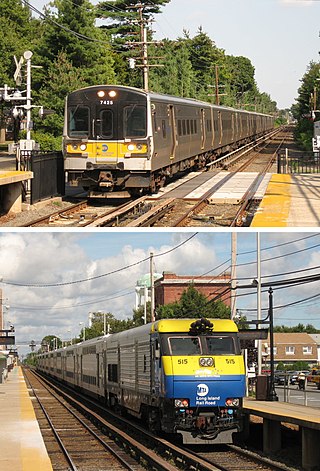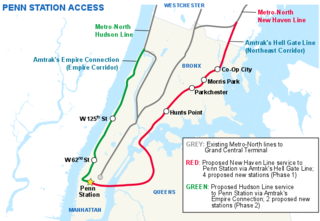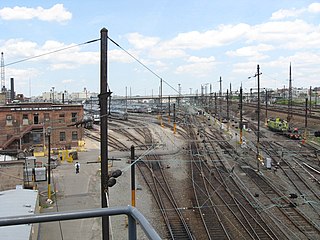
The Long Island Rail Road, often abbreviated as the LIRR, is a railroad in the southeastern part of the U.S. state of New York, stretching from Manhattan to the eastern tip of Suffolk County on Long Island. The railroad currently operates a public commuter rail service, with its freight operations contracted to the New York and Atlantic Railway. With an average weekday ridership of 354,800 passengers in 2016, it is the busiest commuter railroad in North America. It is also one of the world's few commuter systems that runs 24/7 year-round. It is publicly owned by the Metropolitan Transportation Authority, which refers to it as MTA Long Island Rail Road. In 2022, the system had a ridership of 70,342,700, or about 253,800 per weekday as of the second quarter of 2023.

Pennsylvania Station is the main intercity railroad station in New York City and the busiest transportation facility in the Western Hemisphere, serving more than 600,000 passengers per weekday as of 2019. The station is located beneath Madison Square Garden in the block bounded by Seventh and Eighth Avenues and 31st and 33rd Streets and in the James A. Farley Building, with additional exits to nearby streets, in Midtown Manhattan. It is close to several popular Manhattan locations, including Herald Square, the Empire State Building, Koreatown, and Macy's Herald Square.

The Northeast Corridor (NEC) is an electrified railroad line in the Northeast megalopolis of the United States. Owned primarily by Amtrak, it runs from Boston in the north to Washington, D.C., in the south with major stops in Providence, New Haven, Stamford, New York City, Trenton, Philadelphia, Wilmington, and Baltimore. The NEC closely parallels Interstate 95 for most of its length, and, as of 2013, is the busiest passenger rail line in the United States both by ridership and by service frequency. The NEC carries more than 2,200 trains daily.

The New York Tunnel Extension is a combination of railroad tunnels and approaches from New Jersey and Long Island to Pennsylvania Station in Midtown Manhattan.

The West Side Line, also called the West Side Freight Line, is a railroad line on the west side of the New York City borough of Manhattan. North of Penn Station, from 34th Street, the line is used by Amtrak passenger service heading north via Albany to Toronto; Montreal; Niagara Falls and Buffalo, New York; Burlington, Vermont; and Chicago. South of Penn Station, a 1.45-mile (2.33 km) elevated section of the line, abandoned since 1980, has been transformed into an elevated park called the High Line. The south section of the park from Gansevoort Street to 20th Street opened in 2009 and the second section up to 30th Street opened in 2011, while the final section to 34th Street opened in 2014.

Hudson Yards is a neighborhood on the West Side of Midtown Manhattan in New York City, bounded roughly by 30th Street in the south, 41st Street in the north, the West Side Highway in the west, and Eighth Avenue in the east. The area is the site of a large-scale redevelopment program that is being planned, funded, and constructed under a set of agreements among the State of New York, City of New York, and Metropolitan Transportation Authority (MTA), with the aim of expanding the Midtown Manhattan business district westward to the Hudson River. The program includes a major rezoning of the Far West Side, an extension of the New York City Subway's 7 and <7> trains to a new subway station at 34th Street and 11th Avenue, a renovation and expansion of the Javits Center, and a financing plan to fund the various components. The various components are being planned by New York City Department of City Planning and New York City Economic Development Corporation.
The 7 Subway Extension is a subway extension of the New York City Subway's IRT Flushing Line, which is served by the 7 local and <7> express services. The extension stretches 1.5 miles (2.4 km) southwest from its previous terminus at Times Square, at Seventh Avenue and 41st Street, to one new station at 34th Street and Eleventh Avenue. A second station at 10th Avenue and 41st Street was dropped from the plans in October 2007. The entirety of the extension is located within the New York City borough of Manhattan. The extension, a key part of the Hudson Yards Redevelopment Project, is expected to bring business and entertainment into the area, as well as aid redevelopment of nearby Chelsea and Hell's Kitchen, located around the Long Island Rail Road's West Side Yard. The extension also serves the nearby Jacob K. Javits Convention Center.
East Side Access (ESA) is a public works project in New York City that extended the Long Island Rail Road (LIRR) two miles from its Main Line in Queens to the new Grand Central Madison station under Grand Central Terminal on Manhattan's East Side. The Metropolitan Transportation Authority (MTA) project was originally scheduled to open in 2009 but was delayed by more than a decade. The new station and tunnels opened with limited service to Jamaica station in Queens on January 25, 2023, and full service began on February 27, 2023. The estimated cost of the project rose nearly threefold from US$3.5 billion to US$11.1 billion as of April 2018, making it one of the world's most expensive underground rail-construction projects.

The East River Tunnels are four single-track railroad passenger service tunnels that extend from the eastern end of Pennsylvania Station under 32nd and 33rd Streets in Manhattan and cross the East River to Long Island City in Queens. The tracks carry Long Island Rail Road (LIRR) and Amtrak trains travelling to and from Penn Station and points to the north and east. The tracks also carry New Jersey Transit trains deadheading to Sunnyside Yard. They are part of Amtrak's Northeast Corridor, used by trains traveling between New York City and New England via the Hell Gate Bridge.

The North River Tunnels are a pair of rail tunnels that carry Amtrak and New Jersey Transit passenger lines under the Hudson River between Weehawken, New Jersey, and Pennsylvania Station in Manhattan, New York City, New York. Built between 1904 and 1908 by the Pennsylvania Railroad (PRR) to allow its trains to reach Manhattan, they opened for service in late 1910.
The Lower Manhattan–Jamaica/JFK Transportation Project was a proposed public works project in New York City, New York, that would use the Long Island Rail Road's Atlantic Branch and a new tunnel under the East River to connect a new train station near or at the World Trade Center Transportation Hub site with John F. Kennedy International Airport and Jamaica station on the LIRR. It would allow for a one-seat, 36-minute-long ride between JFK Airport and Lower Manhattan, cut commuting times from Long Island by up to 40% and reduce crowding on the IRT Broadway–Seventh Avenue Line, IRT Lexington Avenue Line, IND Eighth Avenue Line, and BMT Broadway Line in Manhattan.
Access to the Region's Core (ARC) was a proposed commuter-rail project to increase passenger service capacity on New Jersey Transit (NJT) between Secaucus Junction in New Jersey and Manhattan in New York City. New infrastructure would have included new trackage, a new rail yard, and a tunnel under the Hudson River. A new station adjacent to New York Penn Station was to be constructed as running more trains into the current station was deemed unfeasible. An estimated budget for the project was $8.7 billion. Construction began in mid-2009 and the project was slated for completion in 2018, but it was cancelled in October 2010 by Chris Christie, the governor of New Jersey, who cited the possibility of cost overruns and the state's lack of funds. Six hundred million dollars had been spent on the project. The decision remains controversial.

The Gateway Program is the planned phased expansion and renovation of the Northeast Corridor (NEC) rail line between Newark, New Jersey, and New York City, New York, along right-of-way between Newark Penn Station and New York Penn Station. The project is to build new rail bridges in the New Jersey Meadowlands and new tunnels under Bergen Hill and the Hudson River, rehabilitate the existing 1910 tunnel, and construct a new terminal annex.

From the start of railroading in America through the first half of the 20th century, New York City and Long Island were major areas for rail freight transportation. However, their relative isolation from the mainland United States has always posed problems for rail traffic. Numerous factors over the late 20th century have caused further declines in freight rail traffic. Efforts to reverse this trend are ongoing, but have been met with limited success.

Pennsylvania Station was a historic railroad station in New York City that was built for, named after, and originally occupied by the Pennsylvania Railroad (PRR). The station occupied an 8-acre (3.2 ha) plot bounded by Seventh and Eighth Avenues and 31st and 33rd Streets in Midtown Manhattan. As the station shared its name with several stations in other cities, it was sometimes called New York Pennsylvania Station. Originally completed in 1910, the aboveground portions of the building were demolished in 1963, and the underground concourses and platforms were heavily renovated to form the current Pennsylvania Station within the same footprint.

Penn Station Access (PSA) is a public works project underway by the Metropolitan Transportation Authority in New York City. The goal of the project is to allow Metro-North Railroad commuter trains to access Penn Station on Manhattan's West Side, using existing trackage owned by Amtrak. Metro-North trains currently terminate exclusively at Grand Central in Midtown Manhattan.

Harold Interlocking is a large railroad junction located in New York City. It is the busiest rail junction in the United States. It serves trains on Amtrak's Northeast Corridor and the Long Island Rail Road's Main Line and Port Washington Branch, which diverge at the junction.

The Hell Gate Line is the portion of Amtrak's high-speed Northeast Corridor between Harold Interlocking in Sunnyside, Queens and Shell Interlocking in New Rochelle, New York.

Moynihan Train Hall is an expansion of Pennsylvania Station, the main intercity and commuter rail station in New York City, into the city's former main post office building, the James A. Farley Building. Located between Eighth Avenue, Ninth Avenue, 31st Street, and 33rd Street in Midtown Manhattan, the annex provides new access to most of Penn Station's platforms for Amtrak and Long Island Rail Road passengers, serving 17 of the station's 21 tracks. The hall is named after Daniel Patrick Moynihan, the U.S. senator who had originally championed the plan. The building's Beaux-Arts exterior resembles that of the original Penn Station; both buildings were designed by the architectural firm of McKim, Mead & White.




















